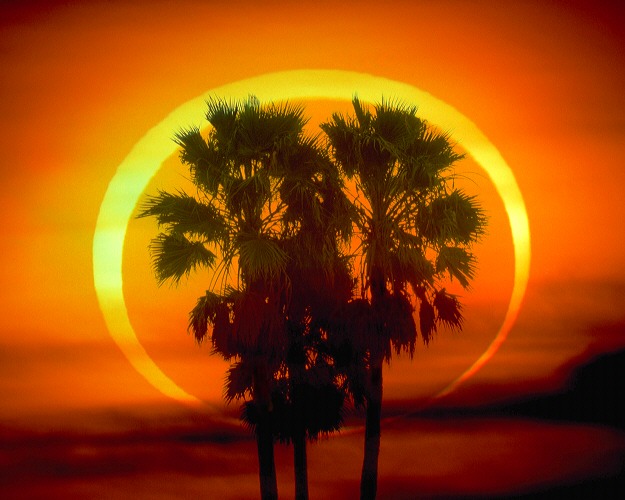Credit & Copyright: Dennis Mammana
(Skyscapes)
Explanation:
Today, a few lucky people will see a "ring of fire."
That's a name for the central view of an
annular eclipse of the
Sun by the
Moon.
At the peak of this eclipse, the middle of the Sun will
appear to be missing and the dark Moon will appear
to be surrounded by the bright Sun.
This will only be
visible, however, from a
path that crosses the Pacific Ocean.
From most locations at most times,
including most of eastern
Asia
and western
North America,
the Moon will only appear to take a
bite out the Sun.
In east Asia, the rising Sun will appear partially
eclipsed on the morning of June 11.
Simultaneously, in much of North America, the same
eclipsed sun
will appear to be setting on June 10.
Remember to
never look directly at the Sun even during an eclipse.
An annular eclipse occurs instead of a
total eclipse when the
Moon is on the far part of its
elliptical orbit around the
Earth.
The next annular eclipse of the Sun will take place in 2003 May,
although a total eclipse will occur later this year in early December.
Pictured above, a spectacular
annular eclipse
was photographed behind palm
trees on 1992 January.
1999 2000 2001 2002 2003 2004 2005 2006 2007 2008 2009 2010 2011 2012 2013 2014 2015 2016 2017 2018 2019 2020 2021 2022 2023 2024 2025 |
Yanvar' Fevral' Mart Aprel' Mai Iyun' Iyul' Avgust Sentyabr' Oktyabr' Noyabr' Dekabr' |
NASA Web Site Statements, Warnings, and Disclaimers
NASA Official: Jay Norris. Specific rights apply.
A service of: LHEA at NASA / GSFC
& Michigan Tech. U.
|
Publikacii s klyuchevymi slovami:
annular solar eclipse - solar eclipse - Solnechnoe zatmenie - kol'ceobraznoe solnechnoe zatmenie
Publikacii so slovami: annular solar eclipse - solar eclipse - Solnechnoe zatmenie - kol'ceobraznoe solnechnoe zatmenie | |
Sm. takzhe:
Vse publikacii na tu zhe temu >> | |
